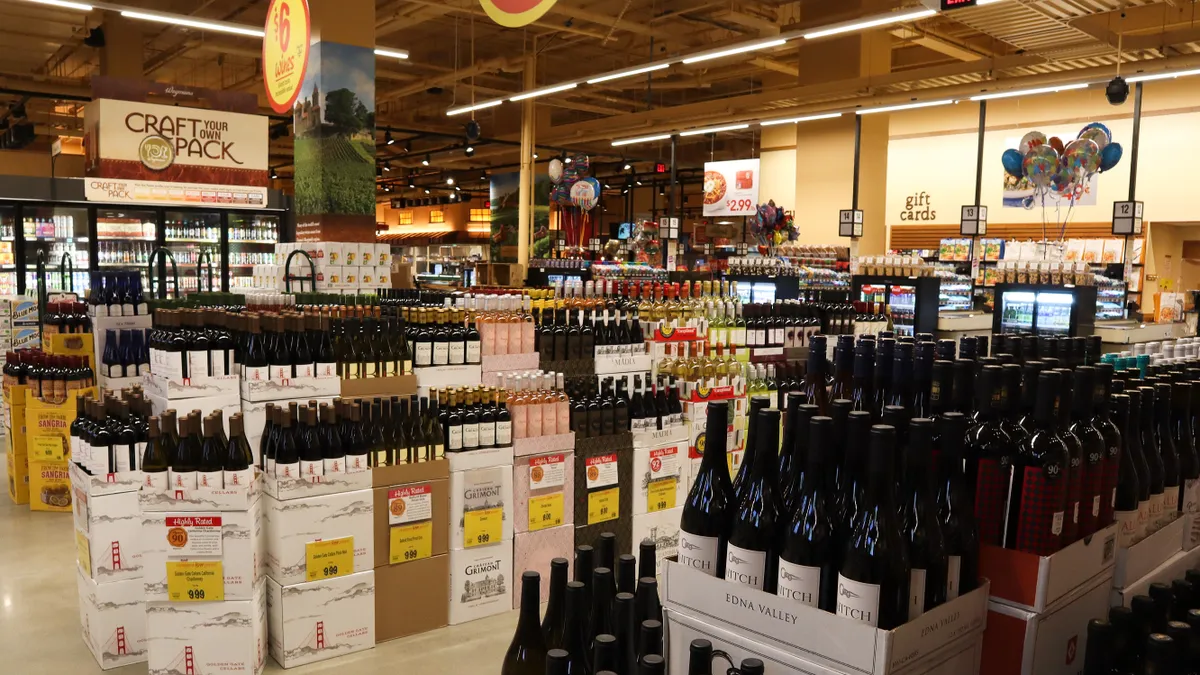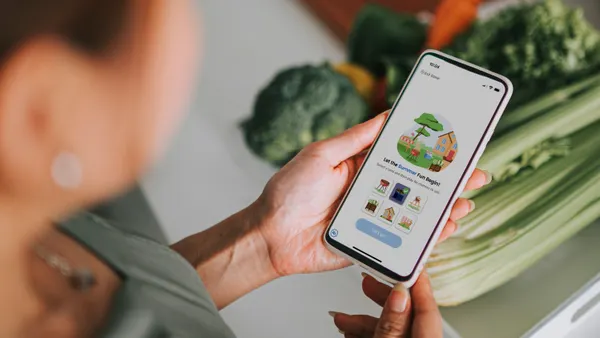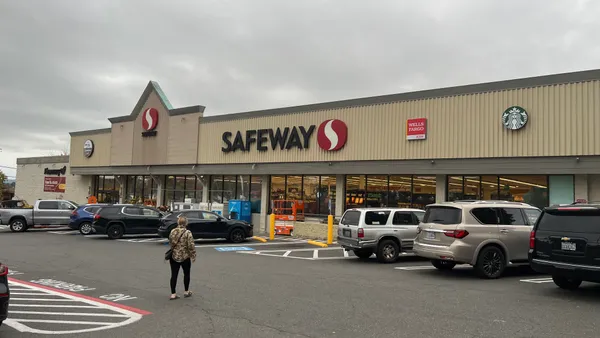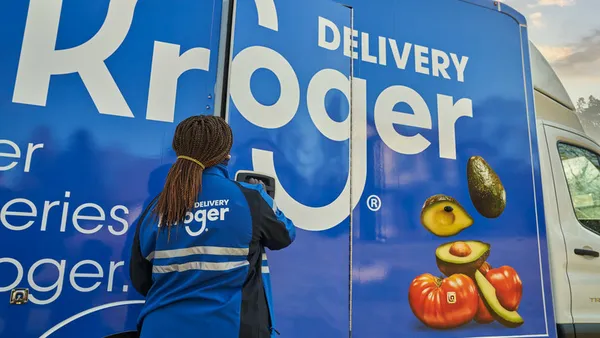Grocers have gotten a pleasant buzz from beverage alcohol sales over the last few years, and the pandemic has only kept growth pouring into the category.
Year-to-date alcohol sales are up $4 billion (21%) in the grocery channel, compared to nearly $8 billion (17%) across all channels, according to IRI data. This has increased the grocery channel’s share of U.S. alcohol sales 1.3 points to 43.8% — the highest market share in five years.
Brad Golden, senior vice president of insights at IRI, said the increase in alcohol sales is driven by on-premise closures, changing shopper behavior, channel shifting and perhaps an increase in alcohol consumption, as well, adding that grocers are benefiting more from the off-premise booze bump than retailers like Walmart and convenience stores.
“Two-thirds of the sales gains in grocery are due to increased spending per trip, which is being driven by two factors: premiumization, which is shoppers buying higher-priced beverages … and secondly, they're buying larger packs,” Golden said, adding that IRI has seen slight increases in market penetration and frequency of shopping trips.
Beer is the top category increasing grocery dollar sales year to date ($1.9 billion), with wine as the fifth ($1.2 billion) and spirits ($900 million) as the eighth biggest contributors out of the 300 categories IRI tracks, Golden said, calling beer “a relatively affordable micro-vacation that has historically performed well during recessions.”

Right now, regulations and restrictions are playing to grocers' advantage. Restaurants and bars have had to severely curb indoor service, spurring shoppers to buy more alcohol at their local grocery store. Several states have also loosened their liquor laws in an effort to boost restaurants as well as retailers. In June, Louisiana expanded a law allowing employees of grocery stores, liquor stores and restaurants to deliver alcoholic beverages, making it legal for third-party delivery services to deliver beer and wine. In August, Georgia’s governor signed a bill allowing grocers to offer home delivery of beer, wine and liquor.
But not all changes have played in grocers' favor. Safety restrictions have required many to shutter the bars, kombucha fountains and other experiences they've invested heavily in, forcing them to shift focus or get creative. Retailers also still face complex regulations in the category that can limit in-store and e-commerce sales.
“I think the big obstacle for capitalizing on the opportunity is the shifting sands of regulation and also how those can be completely unique on a local level,” said Carol Spieckerman, president of retail consulting firm Spieckerman Retail, who noted grocers' alcohol sales are also under threat from discounters.
To keep the momentum going, grocers need to focus on their beverage alcohol selection, utilize online ordering, reassess their in-store experiences and prepare for loosening alcohol restrictions, sources said.
Alcohol departments take center stage
Innovative merchandising and wider, more prominently positioned assortments have taken off at grocery stores, from speakeasy-themed liquor departments to sections where shoppers can select individual bottles of craft beer.
Alcohol departments are increasingly taking center stage. Wegmans' new store in Tysons, Virginia, placed its wine section in a “prominent” spot near the front of the store and next to the registers, rather than in the back, said Matt Collalto, the store’s service area manager. The store also offers “Craft Your Own” six-packs and color-coded shelf signs to help customers find different types of beer.
A Safeway store that opened in Washington, D.C., in August made its alcohol department a focal point with a 500-bottle walk-in cellar, spirits room and an on-call wine steward. Meanwhile, Whole Foods recently opened its second Ideal Market store in Colorado with a bottle room featuring a rotating selection of seasonal, local and limited beers.
Grocers are best advised to make “their liquor departments look more like an upscale liquor store than just a shelf full of booze,” Spieckerman said. Creative merchandising like cheese pairings and liquor-specific loyalty programs are also ways to boost alcohol sales, she said.
If they haven’t already, grocers should get licenses to sell wine, beer and spirits in all of their stores where legally allowed, activate the alcohol category online and focus on communication with consumers, said Bourcard Nesin, beverage analyst for banking and financial services company Rabobank.
When it comes to in-store entertainment centered on alcohol, retailers have been forced to shutter bars and other attractions that were a draw for many customers. Rather than close these fixtures down for good, many grocers have elected to preserve the space and offer limited or no service while shifting promotional focus to the packaged side of the store.
Raley’s, for one, has paused its in-store educational wine tastings and temporarily closed the five wine and beer bars at its stores. Anthony Dyer, the grocer’s senior category manager for alcohol, said in an email that these services will return when it’s safe.
All of The Giant Company’s 143 Beer and Wine Eateries feature bottle and can sales as well as in-store seating for 30 people, which had to shutter during the pandemic. But Colin Heap, beer and wine category manager for Giant, said the impact hasn't been severe since the eateries were primarily takeout businesses to begin with.
“If you’ve got ice cream sitting in your cart, you can't exactly afford to sit down and drink two beers,” Heap said.
Heap saw shoppers at Giant stocking up on alcohol at the start of the pandemic because the state-run liquor stores, which also sell wine, were temporarily closed due to coronavirus restrictions. Those stores have since reopened, and now alcohol sales at Giant stores are roughly split between wine and beer, he said.
“One of the patterns that we saw was customers almost immediately shifted from some of the smaller packages to some of the larger packages, because I think they wanted to make fewer trips to the store and minimize their exposure,” Heap said — a pattern he’s still noticing today.
In June, Wegmans permanently closed its in-store bar/restaurant concept called The Pub, which was in a dozen stores in New York, Pennsylvania and Virginia. But the grocer hasn't given up on on-site alcohol consumption. The newly opened store in Tysons has a Japanese-inspired, full-service bar with hand-crafted cocktails featuring Japanese spirits, local beers on tap, and wine and sake available by the glass. The bar is currently open.
When rethinking on-site alcohol offerings, Golden suggests that grocers stay flexible and carefully research their consumers' preferences. “I don't necessarily think that every grocery chain needs to go out and offer a bar area or a place to have a cocktail while shopping, because I don't necessarily know that their shopper base wants that,” Golden said.
Alcohol delivery and pickup takes off
As online grocery sales have taken flight, a growing number of grocers have also expanded alcohol e-commerce. Lidl recently announced that it’s offering same-day alcohol delivery from more than 40 stores in Virginia and North Carolina through Shipt, while Target has said its plans to expand its alcohol pickup, which is currently at more than 300 stores, to additional locations next year.
Instacart, which expanded its alcohol delivery last year, currently offers the service in 23 states and Washington, D.C., with more than 150 retail partners, including Aldi, Sam’s Club and Sprouts Farmers Market. Mercato, a grocery delivery service that works with independent and specialty stores, said that it recently added features enabling alcohol order fulfillment.
While the majority of Raley’s online beverage alcohol sales are for pickup, there’s been a “significant increase” in delivery since the start of the pandemic, Dyer said. Raley’s offers pickup and delivery through its own e-commerce service, eCart, and also works with Instacart and FoodJets, a local service.
Making alcohol easy to order for pickup, delivery or home shipping is important as grocers and liquor stores see rising competition from direct-to-consumer sites, including Minibar Delivery and Thirstie. Minibar saw its sales shoot up 139% and its average order size increase up to 22% at the start of the pandemic, according to Forbes.
For grocers that can’t fulfill online orders of alcohol or are limited by state or county borders, Spieckerman said transparency and communication with consumers are key. “Customers don't like it when something's in their cart and they think they're ready to check out and get it all delivered and then, all of a sudden, the alcohol vaporizes,” she said.
However, while more retailers are tapping into alcohol e-commerce, many have shied away from the opportunity due to its complexity.
“Supermarkets largely ignored the alcohol category as they rolled out their e-commerce programs. That's largely because it's highly regulated,” Nesin said.
But the challenges are worth the payoff, Nesin and other sources said. While grocers have been skittish about breaking the rules and navigating the age verification component to online orders, sources said that online shopping for alcohol is no riskier than in-store purchases, even though laws make it more complicated.
"If your courier isn't licensed and they violate the rules and give alcohol to someone underage, you [the retailer] are responsible because you're the one holding the license," Nesin gave as an example. By checking IDs and using signature technology, grocers can reduce concerns minors will try to use online orders to buy alcohol, he said.
Grocers stand to lose customers if they don’t figure out how to offer online ordering for alcohol where legally allowed and optimize the experience. “It's not about incremental revenue online,” Nesin said. “It's about revenue protection.”
One avenue Nesin has seen grocers take is partnerships with third-party platforms that can help navigate the category's legal maze and provide an online presence. In August, alcohol e-commerce platform Drizly said its number of retail partners doubled since Jan. 1 and that it grew 350% compared to 2019.
Drinks, a startup that has partnered with Kroger and online wholesale retailer Boxed, offers curated wine through a consumer marketplace and a plug-and-play solution for retailers. The company announced last fall an expansion of Kroger’s online wine store, including a build-your-own-pack feature.
Alcohol has seen “little digital adoption or disruption,” although that’s changing now that the pandemic has accelerated e-commerce, said Zac Brandenberg, founder and CEO of Drinks.
Drinks’ ship-to-home partnership with Kroger allows the grocer to deliver to its core market areas and beyond, he said. Meanwhile, Brandenberg pointed to a multi-year partnership announced this summer between Treasury Wine Estates’ brand 19 Crimes, which uses augmented reality for interactive labels, and rapper Snoop Dogg as an example of creating an interesting shopping experience in wine.
“By selling online, you're not just creating a channel shift or ... transferring those sales from physical stores online, you're really gaining customers. You're gaining market share. You're gaining exposure. You're able to reach more customers in different areas,” he said.
Raley's has made a point of offering in-store pricing and special offers online, including a 30% discount when shoppers buy six or more bottles of 750 milliliter wines. It also offers promotions for multiple purchases from one company, on larger bottles of spirits and select cross-purchases to customers online, Dyer said.
“We also have collections online that we can curate based on purchase occasions such as seasons and holidays,” Dyer said.
Leveraging data to drive strategy
It’s not enough for grocers to just offer their alcohol online, Brandenberg said. They need to use data and content opportunities to target consumers. “The last thing we want, the last thing anybody wants, is this ‘wall of wine’ where you look at it, you have no idea what you want, or how to find what you want, and the struggling and intimidation makes you walk away,” he said.
Online alcohol sales not only expand the grocer's consumer base, but also provide relevant data and content opportunities, like origin stories about where the alcohol came from. Online, grocers can make suggestions, like food or recipe pairings, sources said. Nesin said some retailers have even figured out how to promote alcohol online to age-appropriate audiences.
Startups in the meal planning space are pairing booze with food. For example, eMeals partners with alcohol brands to promote alcohol recommendations to shoppers using the digital meal planning service and then allows subscribers to send their selected food and beverage options to Walmart, Kroger, Amazon, Instacart or Shipt, or shop their lists at stores.
Data also plays a big role in determining selection, retail analysts said. “They have to have advanced enough analytics to know when some of those slower selling niche brands are actually helping drive sales to higher-volume brands,” Spieckerman said.

Offering craft beers and wine, which have seen growing popularity, alongside national brands can send a message that the store is a part of the local community, she said. When it comes to knowing and supporting local brands, Spieckerman said this is where independent operators have an edge over larger grocers.
“If everybody has the same brands, then it can become a race to the bottom on price… craft beers and niche brands — those are an opportunity to make better margins, because the comparisons aren't there,” Spieckerman said.
“There are many growth pockets in alcohol,” Golden said, listing as examples: hard seltzer, ready-to-drink cocktails, frozen cocktails, better-for-you products, and beer and spirits with citrus flavors.
Giant puts an emphasis on local beer and wine and seasonal items that rotate. Heap said stores have been able to take advantage of growing local brewing and distilling efforts in recent years to meet consumer demand.
“We have a section of the set that is set aside for every store to be able to bring in local providers, and I'm proud of that, because customers really do look for that,” Heap said. “They want to support local — perhaps now more than ever.”












